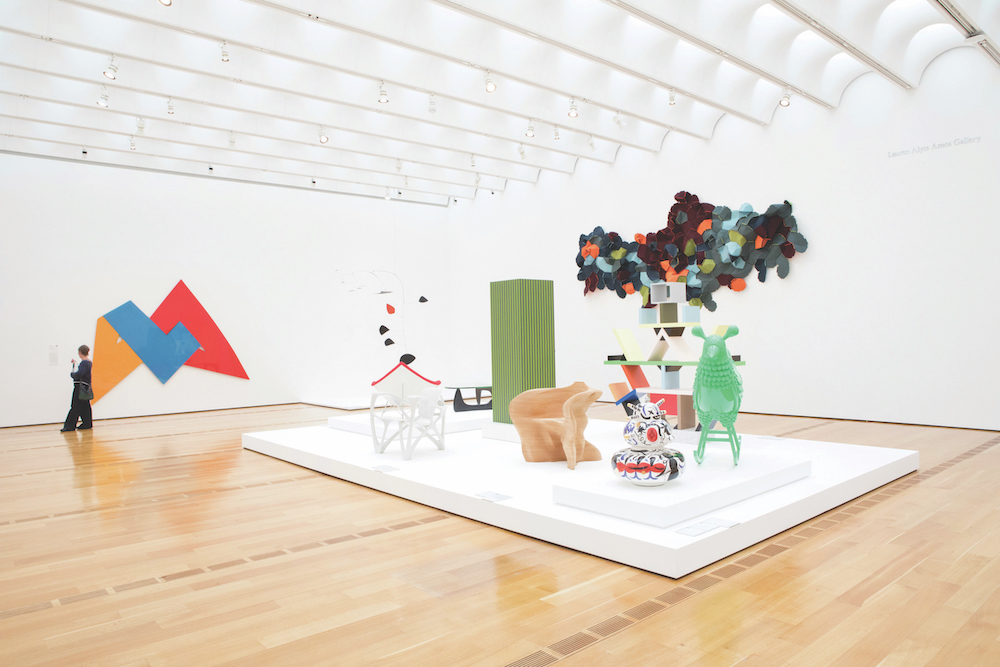
Photograph by Mike Colletta
When Woodruff Arts Center‘s President and CEO, Doug Shipman, greets me on the fourth floor, he’s dressed in a plaid blazer, sneakers, and colorful socks in the style of a cool politician or a millennial tech magnate. It’s a fitting look for someone who both wields immense power and embraces nontraditional priorities, namely to diversify Woodruff Arts Center (WAC)—which is composed of artist partners Alliance Theatre, Atlanta Symphony Orchestra, and the High Museum of Art—while also uplifting Atlanta’s entire arts ecosystem.
Before he got to WAC, Shipman had spent 10 years launching the National Center for Civil and Human Rights (NCCHR). The mission of the museum spoke to him in more ways than one. He’d studied civil rights history in college, but he also saw his role at NCCHR as a way to be part of a transformative experience in people’s lives: bringing them into history, exposing them to new ideas, and providing an instrumental space as Atlanta continued to navigate the ideals of living in a diverse America. Such a deep sense of purpose grew from his previous role as a principal at the Boston Consulting Group, and aligned with his later role as CEO of BrightHouse, a consulting firm that helps companies discover their purpose.
“In the business space, you have a lot of impact and can do things with wide reach, but it’s not as often that you get a note saying, ‘My life is fundamentally better because of the work you helped make happen,’” Shipman says. “That’s what feeds me.”

Photograph by Cat Max Photography
In 2017, when the CEO role at WAC opened up, Shipman saw another opportunity to be part of an institution that could intimately connect with and transform people—this time through the arts. He was also compelled by WAC’s work to grow its reach and bring more people into conversation with the visual and performing arts.
“When I realized it was a deeply held ambition of each of the disciplines—the museum, the theater, and the symphony—to expand their audiences and really think about serving Atlanta, and that the work was already well underway, that’s when I took this position,” he says.
When he talks about diversifying audiences, Shipman’s not just referring to racial and ethnic representation, but also about ensuring there are programs for every age, that you don’t feel like you need a PhD to enter the building, and that it’s equally accessible for those living down the street and for art enthusiasts from around the region.
“What was really compelling to me was this 50-year-old institution that was, frankly, built to be quite exclusive, and now you have all of the folks on this campus wanting to change and make this institution authentically Atlanta,” says Shipman.
Growing up in Arkansas, Shipman didn’t live in a particularly artistic household, a fact which lies in stark contrast to the Fahamu Pecou painting now adorning his office, the Yoyo Ferro hanging in his Old Fourth Ward home, and his professed love of jazz clubs, folk art, and the Tony-winning playwright George C. Wolfe. These days, a passion for art is a family affair for Shipman. He and his wife, Bijal Shah, have intentionally sought to immerse their two daughters, 5 and 7, in Atlanta’s cultural offerings—in fact, they’ve already been to the opera. Shipman says he hopes they continue to cultivate the creativity, curiosity, empathy, and emotional connection to others’ stories that only the arts can inspire.

Photograph by Carlton Taylor
His desire for his daughters to gain these qualities through experiencing the arts is precisely the sort of personal, deeply embedded value system that Shipman wants to understand in others—especially donors. Whether talking to corporate partners or individual philanthropists, Shipman is focused on connecting with people’s sense of purpose. “Most philanthropy is trying to accomplish something, so instead of going to a donor and saying, ‘I have the greatest thing since sliced bread and you ought to fund it,’ the best situation is when the donor’s values and their vision for the future matches what you want.”
Increasingly, those values—particularly from the corporate sector—include ongoing relationships and engagement with the arts, such as volunteer work or employee programming, rather than just writing a check. This kind of deeper relationship between corporate sponsors’ employees and WAC pays itself forward by bringing new patrons into the center of arts.
Cultivating such a culture of arts engagement in Atlanta is important to Shipman. “I’m fortunate enough to be in a position where I can open doors for people,” he says, so in addition to using WAC as a platform to showcase, partner with, or help propel Atlanta artists forward, Shipman says he sees a major part of his role as being a cheerleader for the whole sector. “I try to carve out time to go to openings and shows and to help people make connections—and I use social media to do the same.”
Since Atlanta is still under-tapped in terms of both arts philanthropy and audience engagement as compared to other major cities, every effort to involve Atlantans in any corner of the arts scene ends up benefiting the whole artistic ecosystem. In other words, the arts don’t have to be a competitive zero-sum game. Raising up the arts as a whole in Atlanta helps all individual organizations. Shipman comments, “The truth is we’re not competing against each other; we’re competing against Netflix.” The challenge is to inspire enough enthusiasm for the arts that people break their binge-watching schedule, get off the couch, and out to a show.
This concern for the whole Atlanta arts community is why Shipman is so thrilled about arts venues opening in the suburbs, citing the Cobb Energy Performing Arts Centre as kicking off a trend that now includes Sandy Springs and Lawrenceville, as well as renovations to Grove Park’s theater on the west side, a potential performing arts project south of the city, and burgeoning ideas for other outdoor arts spaces on the BeltLine and in the new quarry development project.
“I’m so excited to see these communities making these investments because I would rather people go to the arts much more frequently so it’s a part of the fabric of their lives, rather than just coming to WAC once a year,” he says. “It’s sort of like parks—you need a park within walking distance, and we need to put the arts within reach for everyone.”

Photograph by Jeff Roffman
These days at WAC, the Atlanta Symphony Orchestra continues to lead the way by diversifying orchestras through its Talent Development Program, and it also housed the Atlanta Music Project until this past summer. The Alliance Theatre has made “radical inclusivity” its mission, continues to curate a diverse slate of shows, and hosts a series of development programs with the goal of featuring underrepresented voices. Meanwhile, the High Museum of Art gained national attention for tripling its non-white attendance by 2017, and in 2018 embarked on a reinstallation of its permanent collection to display more pieces by women and people of color. Shipman is especially excited about the High’s current exhibition featuring Virgil Abloh, the eclectic artist who is creative director of Louis Vuitton’s menswear (on display November 9–March 8), which he feels exemplifies the direction of the museum, and of WAC as a whole: a deeply and broadly talented young, black artist whose genre-bending work offers multiple entry points for all audiences.
As for the future, Shipman says he’s still holding out for a few things that would be transformational for the arts in Atlanta: a dedicated source of public funding; a major outdoor venue to rival New York’s Central Park or Chicago’s Millennium Park; and casual, mid- to low-budget art collecting to become more of a norm.
When I ask if any of that feels utterly daunting, Shipman takes a beat for the first time in our conversation, and then says, plainly, “No,” before following up: “There are daunting things in the world, but we are very fortunate; we are in the joy business. It doesn’t mean we’re not provocative, or that we don’t challenge people, or take on political things, but at the end of the day, people should be glad that they came. Even if it’s hard or if it’s a release, it should lift them in some way. That’s our role in the world: We are the expression of deep humanity.”









![The North Carolina Museum of Natural Sciences’ newest exhibit is a [pre]historic first](https://cdn2.atlantamagazine.com/wp-content/uploads/sites/4/2024/04/DD-3-100x70.jpg)



